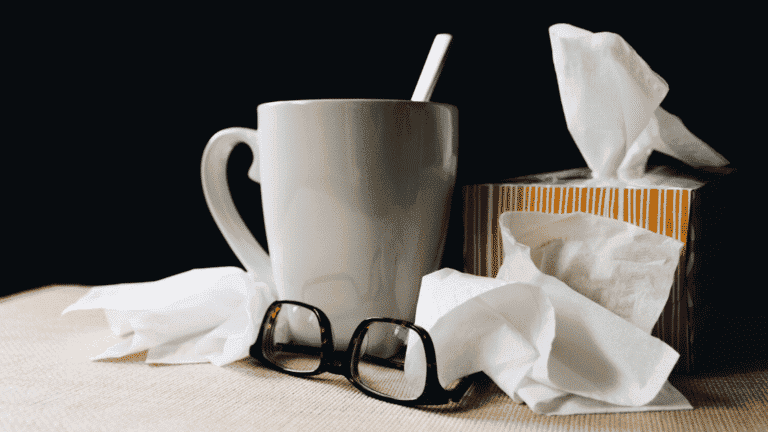101+ Teen Self-Esteem Statistics: Facts We Cannot Ignore in 2024 (infographics)

Our collection of 101 teen self esteem statistics is critical information for anyone who cares about teenagers. Self esteem is closely tied to teens’ mental health, phone and social media use, body image, risk-taking behavior and religion. It’s also heavily influenced by parents, peers and the pandemic.
What Is Self Esteem, Exactly?
Self esteem is a concept that’s not easy to nail down. Definitions from people who research it are complex, but share a few basic ideas in common:
- how worthy we are of happiness
- how successfully we can deal with life’s challenges
- how much we like, value, appreciate and approve of ourselves
But simple and direct is often best! Like Jack Canfield‘s quote about self-esteem. He’s the originator of the Chicken Soup for the Soul books who started his career as a high school teacher.

Regardless of how it’s defined, self esteem has an enormous impact on the identity development and mental health of teenagers.
Why Is Self Esteem So Important in Adolescence?
Part of the reason we start paying more attention to self-esteem issues in teenagers is because this is when self-esteem decreases. Young teens in middle school have better self esteem than older teens in high school.
Teens are becoming more independent while negotiating puberty. They’re developing more self-awareness and paying more attention to where and how they belong. They’re still navigating identity by the time they’re in our classrooms as college students.
Here’s some research that will come as no surprise to parents of teens: As they leave behind the tween years, teenagers increasingly criticize and evaluate their self-worth, and develop more negative feelings and moods.1 They face more stress and more changes in their school and social lives.2
From Minev and colleagues3, a group of scientists who studied self esteem in adolescents:
Self-esteem is central to what we do with our lives – the loyalty we have to developing ourselves and caring for others – and is at the heart of everything that an adolescent will achieve in their life. Self-esteem will influence the adolescent’s performance at school; it will determine how competent the child will be, to what extent that child will be accepted by others and what acceptance they will demonstrate in turn.
Low Self Esteem Vs. High Self Esteem in Teens
Before we get to some pretty sobering teen self esteem statistics, here’s an encouraging fact: most teenagers seem to feel pretty good about themselves through adolescence and into young adulthood.4
When teens have high self esteem, they tend to move toward experiences that likely increase their self esteem even more.5
But when teens have low self esteem, they tend to avoid things to protect themselves. I’ve witnessed this as a high school teacher, college professor and as a mom of teens. This avoidance doesn’t help their self esteem improve and can make it worse.5
So, it’s pretty clear that the self esteem of teenagers is absolutely critical to their growth and development.
READ MORE >>> 5 Reasons for Low Self Esteem in Teenagers
Mental Health & Teen Self-Esteem Statistics
It’s impossible to talk about self esteem for teenagers without addressing their mental health needs. Low self esteem causes depression and anxiety, and both depression and anxiety cause low self esteem.
- Self esteem is “fundamentally associated” with common mental health problems like depression and anxiety.6
- Many previous studies link low self-esteem with depression, anxiety and suicide in adolescents.7,8
- Low self-esteem predicts depression and anxiety.6
- Adolescents with low self esteem are more likely to be at risk for suicide.9
- Depression and anxiety cause lower self-esteem.6
- Teens who do not have positive and supportive relationships with friends and family are more likely to have depressive symptoms.6
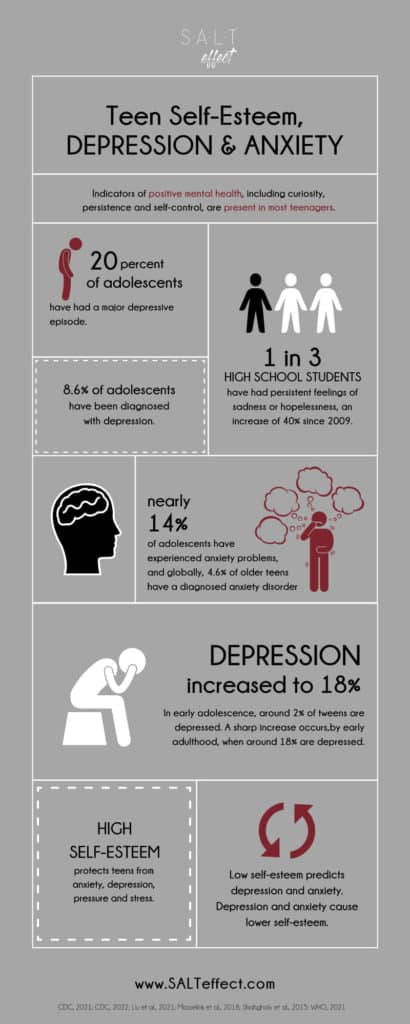
Stats About Teen Depression & Anxiety
The World Health Organization emphasizes the importance of addressing mental health in the adolescent age group, a vulnerable population. If depression and anxiety lead to lower self-esteem, we need to pay even closer attention to teens who are diagnosed with mental health disorders.
- In early adolescence, around 2% of tweens are depressed.5
- A sharp increase occurs by early adulthood, when around 18% are depressed.5
- 42% of high school students have had persistent feelings of sadness or hopelessness, a significant increase since 2011.60
- Nearly 60% of female students and nearly 30% of male students have had persistent feelings of sadness or hopelessness.60
- Almost 70% of LGBQ+ students have had persistent feelings of sadness or hopelessness.60
- 20% of adolescents have had a major depressive episode.11
- 8.6% of adolescents have been diagnosed with depression.11
- Globally, 2.8% of older teens have been diagnosed with depression.12
- Nearly 14% of adolescents have experienced anxiety problems.11
- Globally, 4.6% of older teens have a diagnosed anxiety disorder.12
- 22% of high school students seriously considered attempting suicide and 18% made a suicide plan in 2021.60
- Of the students who seriously considered attempting suicide in 2021, 30% were female and 14% were male. 24% of female students and 12% of male students made a suicide plan.60
- Nearly half of LGBQ+ high school students seriously considered attempting suicide in 2021. 37% made a suicide plan.60
The Good News About Teen Self Esteem & Mental Health
It’s not all bad news when it comes to teens and mental health. Most teens show signs of good mental health and the percentage of teens receiving care for mental health disorders is increasing.
- Indicators of positive mental health (curiosity, persistence and self-control) are present in most teenagers.13
- Nearly 14% of adolescents received mental health treatment.14
- When teens have higher self-esteem, they’re less likely to experience depressive symptoms and mental health disorders15 and it reduces the risk of depression as they enter adulthood.6
- High self-esteem protects teens from anxiety, pressure and stress.16
Teen Self-Esteem Stats About Phones & Social Media
We know technology is both helpful and harmful, but research shows the damage it can do to teen self esteem. It’s also tied to higher rates of depression and anxiety in teens.
- Teens’ phone use leads to poor-quality sleep which is linked to a decline in mental health and self esteem.17
- Sedentary activity (such as media use) has a negative effect on self esteem.8
- Social media platforms “consistently and overly” present idealized body types which contribute to poor body image and self esteem.18
- When teens use their phones excessively, their self esteem is negatively affected.19
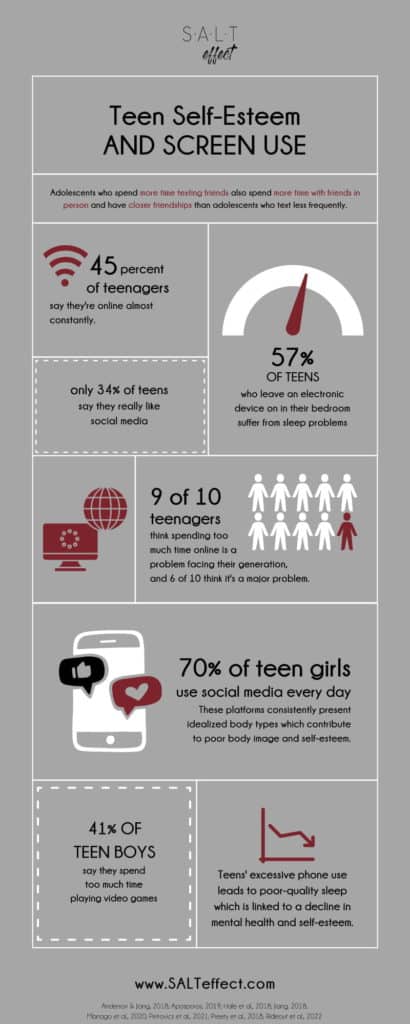
Stats About Teens & Screens
We live in a high-tech society and teens have grown up with easy and regular access to phones, social media, streaming services and more.
- Teens spend 8.5 hours a day on screens for entertainment – watching tv or online videos, playing video games, using social media, etc.24
- 9 of 10 teens think spending too much time online is a problem facing their generation, and 6 of 10 think it’s a major problem.44
- 57% of teens who leave an electronic device on in their bedroom suffer from sleep problems.20
- 58% of middle school students and 73% of high school students do not get enough sleep.21
- Teens experience a significant sleep deficit when they spend more than 2 hours on a screen during the day.22
- 45% of teens say they’re online almost constantly.23
- 70% of teen girls use social media every day.24
- 41% of teen boys say they spend too much time playing video games compared to 11% of girls.45
- 47% of teen girls say they spend too much time on social media compared to 35% of boys.45
The Good News About Screens & Teen Self Esteem
It’s difficult to see the positive side of all this technology for teenagers–especially for parents. But recent research shows it can help teens stay connected to friends and family which strengthens those relationships.
- Only 34% of teens say they really like social media.24
- Adolescents who spend more time texting their friends also spend more time with their friends in person and have closer friendships than adolescents who text less frequently.25
- On average, adolescents who spend more time communicating online tend to have more time in person with their parents.25
- Digital social multitasking (i.e. texting while spending time with someone else) is more accepted among adolescents than previous generations, perhaps because they’ve grown up with ubiquitous phone use.26
- Digital social multitasking for adolescents can often contribute to stronger connections, better friendships and can play a positive role in adolescent development.26
READ MORE >>> Using Tech to Help Tweens Develop Responsibility and 7 Things Parents Need to Know About ChatGPT and AI Tools
Body Image & Teen Self-Esteem Statistics
The mental health and social media use of teenagers are inextricably linked to body image, and all three impact teen self esteem.
- In a study of a highly diverse group of teenagers, self-esteem “consistently hinges” on how attractive they see themselves.27
- Most teenagers (both boys and girls) are dissatisfied with their physical appearance which leads to lower self-esteem, depression, anxiety, risky behaviors and eating disorders.18, 28
- Teen girls feel more dissatisfaction with their bodies than teen boys, and have lower self esteem than boys.29
- Obesity has a negative effect on self esteem for overweight teens.8, 29
- Teen boys who are underweight are more likely to be dissatisfied with their bodies and have lower self-esteem.30
- Disordered eating and poor eating behaviors are associated with low self esteem. 8, 18
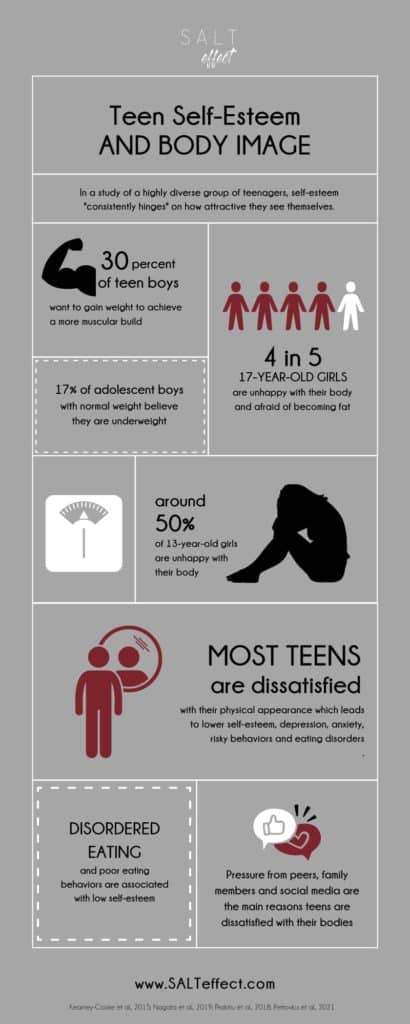
Statistics About Teenagers & Body Image
Both teen boys and teen girls struggle with body image, but more girls are affected. Concerns about being overweight are common among girls, while boys tend to worry more about being underweight.
- Body dissatisfaction is greater among teen girls than teen boys.30
- Around 50% of young girls aged 13 are unhappy with their body.31
- By the time girls are 17 years old, nearly 80% are unhappy with their body.31
- 80% of teenage girls report being afraid of becoming fat.31
- 30% of teenage boys want to gain weight to achieve a more muscular build.32
- Around 17% of adolescent boys with normal weight believe they are underweight.32
- Pressure from peers, family members and social media are the main reasons teens are dissatisfied with their bodies.28
Parent Influence on Teen Self Esteem
Parents have a tremendous impact on the development of a child’s self esteem. Their important role remains strong throughout the teenage years, even as influence grows from peers and media.
Parental Warmth, Parental Monitoring & Parental Control
Before we can look at the facts about parents and the self esteem of teenagers, we need to define a few terms used by scientists: parental warmth, parental monitoring and parental control.
Parental warmth is best understood from the point of view of the child or teen–they don’t just know they’re loved. They feel loved by their parents. Parental warmth is characterized by love, support, affection, involvement, responsiveness and acceptance.33
Parental monitoring includes awareness, attention, watchfulness, tracking and supervision of teen activities. It helps set appropriate boundaries to protect teens from potential harm, but it doesn’t necessarily restrict the teen’s growing independence.
Parental control restricts the freedom, independence and decision-making ability of teenagers.
Facts About Parents & Teen Self Esteem
Style of parenting and the relationship parents have with their kids are two important ways that parents impact a teen’s self esteem.
- Self esteem is largely formed by parents.3
- Teenagers who experience parental warmth tend to have higher self esteem.33
- Parental monitoring is positively associated with self esteem, while parental control is negatively associated with self esteem.33
- Inflated praise (adding “incredibly” or “perfect” to an already-positive statement) is damaging to self esteem.33
- Adolescents who are not close to their parents are at risk for low self esteem.4
- If they have increasing intense conflicts with their parents, teenagers are more likely to develop symptoms of depression, anxiety and low self esteem.34
- Absence of the father is negatively associated with adolescent self-esteem.33
- A mother’s depression can lead to a decrease in a teenager’s self esteem.33
The Good News About Teen Self Esteem & Parents
Parents who wonder if their days of impacting their teens are over should be encouraged by the knowledge that parents definitely matter. A lot.
- The presence of a father means a teen is more likely to have higher self esteem.33
- When teenagers feel supported by family and friends, they’re much more likely to have better self esteem.35
- Support from family matters more to a teen’s self esteem than support from friends.35
- Parents are an important source of self esteem for adolescents and young adults.4
- 86% of high school students experienced high parental monitoring.60
[Build stronger family connections with your teens with 5 simple words. Or use board games to connect with your teen in a fun and low-pressure way.]
READ MORE >>> 11 Tips to Improve Confidence in Teens and Self Esteem and Teenagers: 51 Science-Backed Activities
Peer Influence on Teen Self Esteem
Acceptance and belonging are critical for teenagers, and both significantly impact self esteem. Self esteem also determines how teenagers interpret interactions with peers and difficult situations.
- Peer relationships are important to self esteem throughout adulthood.36
- Feeling accepted by peers is crucial for positive self esteem during adolescence.4
- Teens who have more interpersonal conflicts have lower self esteem because those conflicts mean less acceptance and more rejection.37
- Strong evidence shows that stressful relationships negatively affect people’s self esteem.5
- Low self esteem makes individuals more sensitive to rejection by peers.38
- Teens with low self esteem tend to be shy and uncomfortable in social situations.39
The Vicious Cycle of Low Self Esteem & Negative Interactions
Teens with low self esteem take things more personally in negative interactions, but they don’t take things personally when the feedback is positive. It can become a vicious cycle: low self esteem leads to more negative interactions and relationships which leads to even lower self esteem.
- People with low self esteem view the world more negatively, feeling less like they belong even when others approve of them.40
- Adolescents with low self-esteem have a smaller social network.5
- Adolescents with low self-esteem have more social problems, largely because they tend to interpret interactions in a negative way. When they misjudge a situation, they often fail to respond appropriately which leads to social problems.5
- When teens with low self esteem receive negative feedback, they feel even worse, especially compared to teens with high self esteem who receive negative feedback.41
- Teens with low self esteem have a harder time getting over negative feedback and end up in a worse mood, even when it doesn’t specifically apply to them.41
- Teens with low self esteem don’t seem to respond to positive feedback effectively. Positive feedback is not interpreted as personal or relevant, so it doesn’t improve connections with others or self esteem.41
The Good News About Self Esteem & Peer Relationships
Self esteem for teenagers isn’t solely determined by how accepted they feel among peers. As stated earlier, parent influence on teen self esteem is significant.
- Self esteem improves for most people as they grow up, which means the quality of their relationships are also likely to improve.42
- Teens with higher self esteem interpret social situations more accurately and are more likely to ignore negative feedback that doesn’t apply to them.41
- Positive social experiences have a strong influence on self esteem during adolescence.5
Risk-Taking Behavior & Teen Self-Esteem Statistics
Teens with low self esteem are much more likely to engage in risk-taking behaviors.
Lower self-esteem in teenagers is connected to:
- violent behavior8
- sensation seeking8
- rebelliousness8
- deliquency9
- criminal behavior43
- earlier sexual activity in girls8
- risky sexual behaviors9
- substance use8, 9
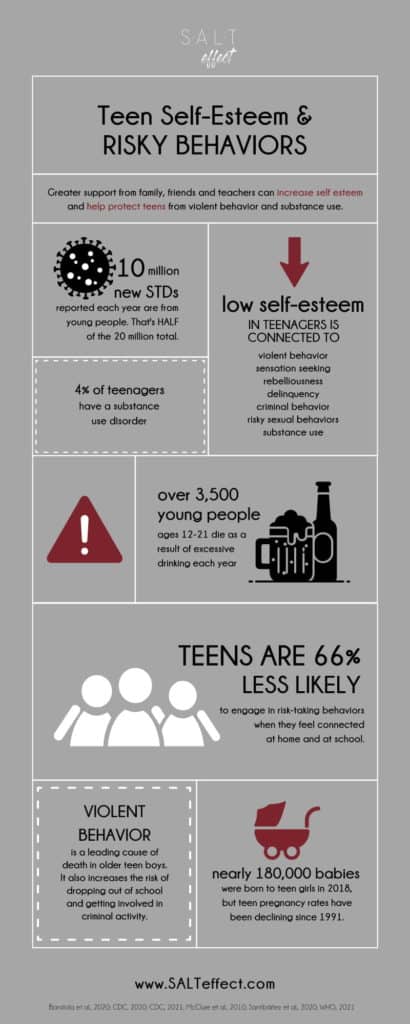
Stats About Teens & Substance Use
- 4% of teenagers have a substance use disorder.12
- 407,000 adolescents (1.6%) have an alcohol use disorder.12
- 788,000 adolescents (3.2%) have an illicit drug use disorder.12
- Nearly 14% of older teens engage in heavy drinking.12
- More than 3,500 people ages 12-21 die as a result of excessive drinking each year.45
- Teenagers consume about 1/10 of all alcohol consumed in the US.46
Stats About Consequences of Risky Teen Behavior
Substance use, violent behavior and sexual activity often mean serious problems and severe consequences for teenagers.
- Most adult smokers had their first cigarette before they were 18 years old.12
- Almost 30% of female high school students drink alcohol and almost 20% use marijuana. Comparatively, almost 20% of male students drink alcohol and almost 15% use marijuana.60
- Teens who drink alcohol-especially those who binge drink-are more likely to experience unwanted, unplanned and unprotected sexual activity, physical and sexual violence, alcohol-related accidents and alcohol poisoning.45
- Teen substance use contributes to adult health problems including heart disease, high blood pressure, sleep disorders and addiction.46
- Violent behavior increases the risk of teenagers dropping out of school, getting involved in criminal activity, being injured or even dying.12
- Violence is a leading cause of death in older teen boys.12
- 30% of high school students have had sexual intercourse.60
- Of sexually active high school students, only 52% used a condom the last time they had sex.60
- 1/2 of the 20 million new STDs each year were among young people (15-24 years old).49
- Teens who are sexually active and don’t use contraceptives have a 90% chance of pregnancy within a year.50
- Over 145,000 babies were born to teen girls in 2021.60
The Good News About Teen Self Esteem & Risk-Taking Behavior
If you review the data above, it’s clear that most teenagers are NOT abusing substances, having sex or engaging in violence and criminal behavior.
- Youth who feel connected at school and at home are 66% less likely to engage in risk-taking behaviors.52
- 61% of high school students feel a sense of school connectedness.60
- Teenage pregnancy and birth rates have continually declined since 1991.60
- The percentage of high school students who have ever had sex has decreased from 47% in 2011 to 30% in 2021.60
- In 2021, teenage illicit drug use showed the largest one-year decrease since 1975.51
- Greater support from family, friends and teachers can increase self esteem and help protect teens from violent behavior and substance use.43
Pandemic Influence on Teen Self Esteem
We’ve had our suspicions about decreased mental health in teens during the pandemic, and a few studies have confirmed it as a public health issue.
- More than 25% of high school students said their emotional and cognitive health worsened since the beginning of the pandemic .53
- Compared to years before the pandemic, tweens and young teens had less healthy lifestyles during confinement due to COVID-19 which led to a negative affect on self esteem, especially for girls.1
- Adolescents with low socioeconomic status (SES) had lower self esteem. Parents tended to have more unstable job positions and were less likely to be able to work from home.1
- Girls had less physical activity and lower self esteem than boys during confinement.1
- Girls spent more time on social media and reported following accounts focused on appearance which had a negative influence on self esteem.1
- Students who had been infected with COVID-19 showed lower self esteem and greater anxiety symptoms.1
- Tween and teen media use increased by 17% from 2019 to 2021.24
Religion & Teen Self-Esteem Statistics
- Religious involvement is related to higher overall self esteem.54, 55
- Higher self esteem is associated with adolescents who participate in more relaxed and less-structured religious activities, such as prayer, mindfulness and meditation.56
- Higher self esteem is also associated with attending church, participating in youth groups and being involved in Bible study.57
- Some studies have found that religious involvement and self esteem are not related for adolescents.58. 59
References
- Villodres, G. C., García-Pérez, L., Corpas, J. M., & Muros, J. J. (2021). Influence of confinement due to COVID-19 on physical activity and Mediterranean diet adherence and its relationship with self-esteem in pre-adolescent students. Children, 8(10), 848. https://doi.org/10.3390/children8100848
- Goodman E., McEwen B. S., Dolan L. M., Schafer-Kalkhoff T., & Adler N. E. (2005). Social disadvantage and adolescent stress. Journal of Adolescent Health, 37, 484–92. 10.1016/j.jadohealth.2004.11.126
- Minev, M., Petrova, B., Mineva, K., Petkova, M., & Strebkova, R. (2018). Self-esteem in adolescents. Trakia Journal of Sciences, 16(2), 114–118. https://doi-org.proxy.lib.ohio-state.edu/10.15547/tjs.2018.02.007
- Birkeland, M.S., Breivik, K., & Wold, B. (2014). Peer acceptance protects global self-esteem from negative effects of low closeness to parents during adolescence and early adulthood. J ournal of Youth Adolescence, 43, 70–80. https://doi.org/10.1007/s10964-013-9929-1
- Masselink, M., Van Roekel, E., & Oldehinkel, A. J. (2018). Self-esteem in early adolescence as predictor of depressive symptoms in late adolescence and early adulthood: The mediating role of motivational and social factors. Journal of Youth and Adolescence, 47(5), 932–946. https://doi.org/10.1007/s10964-017-0727-z
- Liu, Q., Jiang, M., Li, S., & Yang, Y. (2021). Social support, resilience, and self-esteem protect against common mental health problems in early adolescence: A nonrecursive analysis from a two-year longitudinal study. Medicine, 100(4), e24334. https://doi.org/10.1097/MD.0000000000024334
- Flores-Cornejo, F., Kamego-Tome, M., Zapata-Pachas, M. A., & Alvarado, G. F. (2017). Association between body image dissatisfaction and depressive symptoms in adolescents. Revista Brasileira de Psiquiatria, 39(4), 316–322. https://doi-org.proxy.lib.ohio-state.edu/10.1590/1516-4446-2016-1947
- McClure, A. C., Tanski, S. E., Kingsbury, J., Gerrard, M., & Sargent, J. D. (2010). Characteristics associated with low self-esteem among US adolescents. Academic Pediatrics, 10(4), 238–244. https://doi.org/10.1016/j.acap.2010.03.007
- Banstola, R. S., Ogino, T., & Inoue, S. (2020). impact of parents’ knowledge about the development of self-esteem in adolescents and their parenting practice on the self-esteem and suicidal behavior of urban high school students in Nepal. International Journal of Environmental Research And Public Health, 17(17), 6039. https://doi.org/10.3390/ijerph17176039
- Centers for Disease Control and Prevention. (2021). Poor mental health is a growing problem for adolescents. https://www.cdc.gov/healthyyouth/mental-health/index.htm
- Centers for Disease Control and Prevention. (2022). Mental health surveillance among children–United States, 2013-2019. https://www.cdc.gov/mmwr/volumes/71/su/su7102a1.htm
- World Health Organization. (2021, November 17). Adolescent mental health. https://www.who.int/news-room/fact-sheets/detail/adolescent-mental-health
- Centers for Disease Control and Prevention. (2022, March 4). Children’s mental health: Data & statistics. https://www.cdc.gov/childrensmentalhealth/data.html
- Centers for Disease Control and Prevention. (2020, September). Mental health treatment among children aged 5-17 years: United States, 2019. https://www.cdc.gov/nchs/products/databriefs/db381.htm
- Carter, J., Dellucci, T., Turek, C., & Mir, S. (2015). Predicting depressive symptoms and weight from adolescence to adulthood: Stressors and the role of protective factors. Journal of Youth & Adolescence, 44(11), 2122–2140. https://doi-org.proxy.lib.ohio-state.edu/10.1007/s10964-015-0301-5
- Shahgholy Ghahfarokhi, F., Moradi, N., Alborzkouh, P., Radmehr, S., & Zainali, M. (2015). The impact of training problem-solving skills on self-esteem and behavioral adjustment in teenage girls who have irresponsible parents or no parents. Journal of Medicine & Life, 8, 125–131.
- Preety, R., Devi, R. G., & Priya, A. J. (2018). Sleep deprivation and cell phone usage among teenagers. Drug Invention Today, 10(10), 2073–2075.
- Petrovics, P., Nagy, A., Sandor, B., Palfi, A., Szekeres, Z., Toth, K., & Szabados, E. (2021). Examination of self-esteem, body image, eating attitudes and cardiorespiratory performance in adolescents. International Journal of Environmental Research and Public Health, 18(24), 131-172. https://doi.org/10.3390/ijerph182413172
- Kim, H., Choi, I. Y., & Kim, D. J. (2020). Excessive smartphone use and self-esteem among adults with internet gaming disorder: Quantitative survey study. JMIR mHealth and uHealth, 8(9), 185-205. https://doi.org/10.2196/18505
- Hale, L., Kirschen, G. W., LeBourgeois, M. K., Gradisar, M., Garrison, M. M., Montgomery-Downs, H., Kirschen, H., McHale, S. M., Chang, A. M., & Buxton, O. M. (2018). Youth screen media habits and sleep: Sleep-friendly screen behavior recommendations for clinicians, educators, and parents. Child and Adolescent Psychiatric Clinics of North America, 27(2), 229–245. https://doi.org/10.1016/j.chc.2017.11.014
- Wheaton, A. G., Jones, S. E., Cooper, A. C., & Croft, J. B. (2018, January 26). Short sleep duration among middle school and high school students – United States, 2015. Morbidity and Mortality Weekly Report, 67(3), 85-90. doi: 10.15585/mmwr.mm6703a1.
- Hysing, M., Pallesen, S., Stormark, K. M., Jakobsen, R., Lundervold, A. J., & Sivertsen, B. (2015). Sleep and use of electronic devices in adolescence: results from a large population-based study. BMJ Open, 5(1), e006748. doi: 10.1136/bmjopen-2014-006748.
- Anderson, M., & Jiang, J. (2018, May 31). Teens, social media and technology 2018. Pew Research Center. https://www.pewresearch.org/internet/2018/05/31/teens-social-media-technology-2018/
- Rideout, V., Peebles, A., Mann, S., & Robb, M. B. (2022). Common Sense census: Media use by tweens and teens, 2021. San Francisco, CA: Common Sense. https://www.commonsensemedia.org/sites/default/files/research/report/8-18-census-integrated-report-final-web_0.pdf
- Manago, A. M., Brown, G., Lawley, K. A., & Anderson, G. (2020). Adolescents’ daily face-to-face and computer-mediated communication: Associations with autonomy and closeness to parents and friends. Developmental Psychology, 56(1), 153-164. http://dx.doi.org.proxy.lib.ohio-state.edu/10.1037/dev0000851
- Yang, C. C., Pham, T., & Ariati, J. (2021). Digital social multitasking (DSMT), friendship quality, and basic psychological needs satisfaction among adolescents: Perceptions as mediators. Journal of Youth Adolescence, 50, 2456–2471. https://doi-org.proxy.lib.ohio-state.edu/10.1007/s10964-021-01442-y
- Baudson, T. G., Weber, K. E., & Freund, P. A. (2016). More than only skin deep: Appearance self-concept predicts most of secondary school students’ self-esteem. Frontiers in Psychology, 7, 1568. https://doi.org/10.3389/fpsyg.2016.01568
- Prabhu, S., & D’Cunha, D. (2018). Comparison of body image perception and the actual BMI and correlation with self-esteem and mental health: A cross-sectional study among adolescents. International Journal of Health & Allied Sciences, 7(3), 145–149. https://doi-org.proxy.lib.ohio-state.edu/10.4103/ijhas.IJHAS_65_16
- Fernández-Bustos, J. G., Infantes-Paniagua, Á., Cuevas, R., & Contreras, O. R. (2019). Effect of physical activity on self-concept: Theoretical model on the mediation of body image and physical self-concept in adolescents. Frontiers in Psychology, 10, 1537. https://doi.org/10.3389/fpsyg.2019.01537
- van den Berg, P. A., Mond, J., Eisenberg, M., Ackard, D., & Neumark-Sztainer, D. (2010). The link between body dissatisfaction and self-esteem in adolescents: Similarities across gender, age, weight status, race/ethnicity, and socioeconomic status. The Journal of Adolescent Health, 47(3), 290–296. https://doi.org/10.1016/j.jadohealth.2010.02.004
- Kearney‐Cooke, A., & Tieger, D. (2015). Body image disturbance and the development of eating disorders. In L. Smolak & M. D. Levine (Eds.), The Wiley Handbook of Eating Disorders (pp. 283-296). West Sussex, UK: Wiley.
- Nagata, J. M., Bibbins-Domingo, K., Garber, A. K., Griffiths, S., Vittinghoff, E., & Murray, S. B. (2019). Boys, bulk, and body ideals: Sex differences in weight-gain attempts among adolescents in the United States. Journal of Adolescent Health, 64(4), 450-453.
- Krauss, S., Orth, U., & Robins, R. W. (2020). Family environment and self-esteem development: A longitudinal study from age 10 to 16. Journal of Personality and Social Psychology, 119(2), 457–478. https://doi.org/10.1037/pspp0000263
- Silva, K., Ford, C. A., & Miller, V. A. (2020). Daily parent–teen conflict and parent and adolescent well-being: The moderating role of daily and person-level warmth. Journal of Youth & Adolescence, 49(8), 1601–1616. https://doi-org.proxy.lib.ohio-state.edu/10.1007/s10964-020-01251-9
- Greene, M. L., & Way, N. (2005). Self‐esteem trajectories among ethnic minority adolescents: A growth curve analysis of the patterns and predictors of change. Journal of Research on Adolescence, 15(2), 151–178.
- Gruenenfelder-Steiger, A. E., Harris, M. A., &, Fend, H. A. (2016). Subjective and objective peer approval evaluations and self-esteem development: A test of reciprocal, prospective, and long-term effects. Developmental Psychology, 52(10):1563-1577. doi: 10.1037/dev0000147. PMID: 27690495
- Kiviruusu, O., Berg, N., Huurre, T., Aro, H., Marttunen, M., & Haukkala, A. (2016). Interpersonal conflicts and development of self-esteem from adolescence to mid-adulthood. A 26-year follow-up. PloS One, 11(10), e0164942. https://doi.org/10.1371/journal.pone.0164942
- Chen B.-B., Shi, Z., & Wang, Y. (2016). Do peers matter? Resistance to peer influence as a mediator between self-esteem and procrastination among undergraduates. Frontiers in Psychology, 7. DOI=10.3389/fpsyg.2016.01529
- Malik, T., & Rafique, R. (2013). Parental bonding and its association with shyness, self-esteem and self-image in teenagers. Journal of Behavioural Sciences, 23(3), 102-115.
- Ali Ammar, M. A. (2021). Development and initial validation of sense of belonging scale for adolescents (SOBS): Preliminary investigation. ASEAN Journal of Psychiatry, 22(10), 1–22.
- van Schie, C. C., Chiu, C. D., Rombouts, S., Heiser, W. J., & Elzinga, B. M. (2018). When compliments do not hit but critiques do: An fMRI study into self-esteem and self-knowledge in processing social feedback. Social Cognitive and Affective Neuroscience, 13(4), 404–417. https://doi.org/10.1093/scan/nsy014
- Harris, M. A., & Orth, U. (2019, September 26). The link between self-esteem and social relationships: A meta-analysis of longitudinal studies. Journal of Personality and Social Psychology. Advance Online Publication. http://dx.doi.org/10.1037/pspp0000265
- Santibáñez, R., Solabarrieta, J., & Ruiz-Narezo, M. (2020). School well-being and drug use in adolescence. Frontiers in Psychology, 11, 1668. https://doi.org/10.3389/fpsyg.2020.0166
- Aposporos, D. (2019, February 4). News: Teens and their cellphones: How much is too much? The Pew Charitable Trusts. https://www.pewtrusts.org/en/trust/archive/winter-2019/news-teens-and-their-cellphones-how-much-is-too-much
- Centers for Disease Control and Prevention. (2021, October 6). Underage drinking. https://www.cdc.gov/alcohol/fact-sheets/underage-drinking.htm
- Centers for Disease Control and Prevention. (2020, February 10). Teen substance use and risks. https://www.cdc.gov/ncbddd/fasd/features/teen-substance-use.html
- Jiang, J. (2018, August 22). How teens and parents navigate screen time and device distractions. Pew Research Center. https://www.pewresearch.org/internet/2018/08/22/how-teens-and-parents-navigate-screen-time-and-device-distractions/#fn-21096-1
- Centers for Disease Control and Prevention. (2021, November 15). Reproductive health: Teen pregnancy. https://www.cdc.gov/teenpregnancy/about/index.htm
- Centers for Disease Control and Prevention. (2021, June 14). Adolescent and school health: Sexual risk behaviors. https://www.cdc.gov/healthyyouth/sexualbehaviors/index.htm
- DoSomething.org. (n.d.). 11 facts about teen pregnancy. https://www.dosomething.org/us/facts/11-facts-about-teen-pregnancy#fnref9
- National Institute on Drug Abuse. (2021, December 15). Monitoring the Future 2021 survey results. https://nida.nih.gov/drug-topics/trends-statistics/infographics/monitoring-future-2021-survey-results
- Centers for Disease Control and Prevention. (2020, October 8). Adolescent and school health: Adolescent connectedness. https://www.cdc.gov/healthyyouth/protective/youth-connectedness-important-protective-factor-for-health-well-being.htm
- Kaiser Family Foundation. (2021, May 26). The pandemic’s impact on children’s mental health. https://www.kff.org/coronavirus-covid-19/press-release/the-pandemics-impact-on-childrens-mental-health/
- Le, T., Tov, W., & Taylor, J. (2007). Religiousness and depressive symptoms in five ethnic adolescent groups. International Journal for the Psychology of Religion, 17(3), 209–232. https://doi-org.proxy.lib.ohio-state.edu/10.1080/10508610701402259
- Ball, J., Armistead, L., & Austin, B. (2003). The relationship between religiosity and adjustment among African-American, female, urban adolescents. Journal of Adolescence, 26(4), 431. https://doi-org.proxy.lib.ohio-state.edu/10.1016/S0140-1971(03)00037-X
- Plumwongrot, P., & Pholphirul, P. (2021). Participating in religious activities and adolescents’ self-esteem: Empirical evidence from Buddhist adolescents in Thailand. International Journal of Adolescence & Youth, 26(1), 185–200. https://doi-org.proxy.lib.ohio-state.edu/10.1080/02673843.2021.1890161
- Markstrom, C. A. (1999). Religious involvement and adolescent psychosocial development. Journal of Adolescence, 22, 205–221.
- Ciarrochi, J., & Heaven, P. C. L. (2012). Religious values and the development of trait hope and self-esteem in adolescents. Journal for the Scientific Study of Religion, 51, 676-688.
- Milot, A. S., & Ludden, A. B. (2009). The effects of religion and gender on well-being, substance use, and academic engagement among rural adolescents. Youth & Society, 40(3), 403–425. https://doi-org.proxy.lib.ohio-state.edu/10.1177/0044118X08316668
- Centers for Disease Control and Prevention. (2023, February). Youth risk behavior survey: Data summary & trends report (2011 – 2021). https://www.cdc.gov/healthyyouth/data/yrbs/pdf/YRBS_Data-Summary-Trends_Report2023_508.pdf

![101 Stats About Teen Self Esteem We Cannot Ignore [infographics] pin - Text is in white at top right of pin. Background is dark gray and image of teenagers is in the middle of the pin.](https://www.salteffect.com/wp-content/uploads/2022/06/101-Stats-About-Teen-Self-Esteem-We-Cannot-Ignore-infographics-1-150x150.jpg)


